Scientists hope to find out more about bees’ survival strategies after discovering 3,000-year-old mummified solitary bee larvae in Portugal.
Researchers from Lisbon and Seville said the bees, which were ready to leave their cells, had been “in an exceptional state of conservation.”
Upon finding the bulb-shaped objects, they did not expect ever to find out which species had created them. The scientists then found the intact sealed cocoons.
Seville University’s Prof Fernando Muniz explained that finding insects in such an excellent state of fossilisation would be an “extremely rare” occasion as their skeletons usually decompose quickly.
The Spanish expert on mineralogy and agricultural chemistry revealed that his team also detected pollen in the bee cells discovered in rocks near Portugal’s Atlantic coast.
The discovery, which was made in southwestern Portugal, reportedly represents a “unique opportunity” to examine the well-conserved architecture of the nesting sites in greater detail to establish the environmental causes that led to the insects’ death.
The experts from Lisbon University and the University of Seville explained that the area where the discovery had been made had experienced cold periods with intense wintertime rainfall. The time span is known as the Neoglacial interval.
They now want to find out more about the bee population at that time in this part of Portugal.
Carlos Neto de Carvalho is a researcher at Lisbon University’s Faculty of Sciences.
He said: “Discovering and interpreting the ecological reasons for the presence of this population of bees and why they died and were mummified 3,000 years ago may help us to understand and establish strategies for resilience in the face of climate change, such as comparing the ecological imbalances caused by natural parameters and the current ones and the way in which they are affecting the bee species of today.”
Solitary bees are still an essential element of the ecosystem. They do not produce honey. However, the thousands of wild bee species that exist in the world are busy pollinators.
The Ananova page is created by and dedicated to professional, independent freelance journalists. It is a place for us to showcase our work. When our news is sold to our media partners, we will include the link here.




